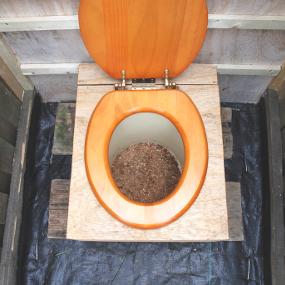Build it Back Greenbushfires
Compost Toilets and Blackwater
 While composting toilets have been popular on rural
and 'off pipe' locations such as national parks for years,
increasingly people are interested in composting their sewage on
site.
While composting toilets have been popular on rural
and 'off pipe' locations such as national parks for years,
increasingly people are interested in composting their sewage on
site.
Composting toilets can help save potable water that would have been flushed down the drain.
The most common type of composting toilet uses a dry system. The user often adds a small scoop of dry bulking material (sawdust, leaf mould or shredded straw).
The pedestal they sit on is connected to a composting chamber, through a short or long chute.
There are two main types of dry composting system, namely continuous and batch systems, with the main difference in the chamber configuration and management practices. Continuous systems employ a single chamber, which is sloped. The waste moves from the top of the pile down, and as it is composted is removed from the bottom of the chamber. The original Clivus Multrum, commercialised in the 1960s, is the prime example of this system.
Batch systems use a series of chambers. Each chamber is used until full, when it is put into storage for six to 12 months. The batch system effectively isolates the compost for a period while it has time to break down. Various systems have different numbers of chambers and configurations. The Australian Rota-loo system is the most common batch system toilet. There is also a range of water-based composting or treatment systems. Wet systems vary in the way they work. Some are designed to deal with all household grey and blackwater, which is convenient if it is difficult to isolate the outlet pipes. Other systems take only a little water, such as from a low-flush toilet.
Wet systems are also usually home to worms, with a nutrient-rich liquid disposed of via trenches or mounds. Wet composting can treat all household wastewater as well as kitchen and green waste. As with dry systems, the health of the bacteria and other organisms is important, so any water introduced should be free of chemical pollutants. Some wet composting systems include greywater processing trenches or reed beds, with excess water from the system absorbed by plants or the ground. As with dry systems, compost must be removed periodically and carefully buried.
Bio-membrane treatment systems are relatively new on the market. These systems use biological treatment and aeration, then filter the water through membranes. The water can be stored and recycled. Additional disinfection can be provided via ultraviolet light, with electricity consumption on these systems up to three kilowatt-hours a day.
The main risk is a poorly performing system. A putrid compost pile can lead to the transfer of pathogens. Keep up basic personal hygiene when maintaining your system. There is no such thing as a maintenance-free composting toilet. Depending on the system, you'll need to carry out a range of tasks such as raking the pile, cleaning the chute and removing the compost. Manufacturers will document maintenance requirements for the toilet. The composted material will need to be emptied from the compost chamber and, by law, buried around 30cm below the soil surface. If you don't want to empty the compost you can outsource this to companies that specialise in this service. A contract may cost between $200 and $500 a year.
In Victoria all systems need to be selected from those approved by the Environment Protection Authority (EPA) systems sold in Australia loosely conform to the relevant Australian and New Zealand Standard for composting toilets, AS/NZS1546.2. A permit also needs to be obtained from the council prior to installation. In rural areas, council planning approvals will be easier as councils are used to processing approvals for on-site waste disposal. In fact, council staff sometimes recommend composting systems due to issues with septic systems. The waste in a sceptic system is not treated to a high degree and can leach into surrounding soil and groundwater causing pollution. Composting toilets use a biological system to breakdown the waste which can then be composted on the property.
A site and soil assessment and a sewerage system plan need to be prepared and approved by the council.
Suppliers
A&A Worm Farm - www.wormfarm.com.au
Ph. 03 5979 1887
Aqua Clarus - www.aquaclarus.com
Ph. 1300 368 158
Biolytix - www.biolytix.com
Ph. 1300 881 472
Cilvus Multrum - www.clivusmultrum.com.au
Ph. 1300 138 182
Ecoflo - www.ecoflo.net.au
Ph. 1300 768 013
Environment Equipment - www.rotaloo.com
Ph. 1800 250 950
Listed suppliers are a guide and are not endorsed by Green Cross Australia or the Alternative Technology Association.




